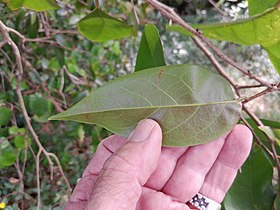| Bernie's Cleistanthus | |
|---|---|

| |
| Conservation status | |
 Least Concern (IUCN 3.1) | |
| Least Concern (NCA) | |
| Scientific classification | |
| Kingdom: | Plantae |
| Clade: | Tracheophytes |
| Clade: | Angiosperms |
| Clade: | Eudicots |
| Clade: | Rosids |
| Order: | Malpighiales |
| Family: | Phyllanthaceae |
| Genus: | Cleistanthus |
| Species: | C. hylandii |
| Binomial name | |
| Cleistanthus hylandii Airy Shaw | |
Cleistanthus hylandii, commonly known as Bernie's Cleistanthus, is an evergreen plant in the family Phyllanthaceae which is endemic to Cape York Peninsula in far northern Queensland, Australia.
Description
Cleistanthus hylandii is a shrub or small tree up to 8 m (26 ft) high. The leaves are simple and alternate, and held on petioles from 2 to 15 mm (0.1 to 0.6 in) long. Leaves are mostly glabrous (without hairs) and are ovate to elliptic. New growth is pink or reddish.
The inflorescences are produced either terminally or in the leaf axils, the flowers very small at about 2 mm (0.1 in) diameter. The fruit is a brown to green capsule about 7 mm (0.3 in) diameter.
Taxonomy
This species was first described in 1976 by the English botanist Airy Shaw, based on material collected by the Australian botanist Bernard Hyland near the Claudie River in Cape York Peninsula. His paper, titled New or Noteworthy Australian Euphorbiaceae was published in the Kew Bulletin.
Etymology
The genus name Cleistanthus is derived from the Ancient Greek words kleistós (closed), and ánthos (flower), and refers to the petals being enclosed by the sepals in some species. The species epithet hylandii was chosen by Shaw to honour Hyland.
Conservation
This species is listed by both IUCN and the Queensland Department of Environment and Science as least concern.
Gallery
References
- IUCN SSC Global Tree Specialist Group & Botanic Gardens Conservation International (BGCI). (2021). "Cleistanthus hylandii". IUCN Red List of Threatened Species. 2021: e.T192496172A192496174. doi:10.2305/IUCN.UK.2021-1.RLTS.T192496172A192496174.en. Retrieved 8 October 2022.
- ^ "Species profile—Cleistanthus hylandii". Queensland Department of Environment and Science. Queensland Government. 2022. Retrieved 8 October 2022.
- ^ "Cleistanthus hylandii". Australian Plant Name Index (APNI). Centre for Australian National Biodiversity Research, Australian Government. Retrieved 12 May 2023.
- "Cleistanthus hylandii Airy Shaw". Plants of the World Online. Royal Botanic Gardens, Kew. Retrieved 8 October 2022.
- ^ F.A.Zich; B.P.M.Hyland; T.Whiffen; R.A.Kerrigan (2020). "Cleistanthus hylandii". Australian Tropical Rainforest Plants Edition 8 (RFK8). Centre for Australian National Biodiversity Research (CANBR), Australian Government. Retrieved 8 October 2022.
- ^ Spokes, T.M.; Forster, P.I. (2022). Kodela, P.G. (ed.). "Cleistanthus hylandii". Flora of Australia. Australian Biological Resources Study, Department of Climate Change, the Environment and Water: Canberra. Retrieved 12 May 2023.
- ^ Cooper, Wendy; Cooper, William T. (June 2004). Fruits of the Australian Tropical Rainforest. Clifton Hill, Victoria, Australia: Nokomis Editions. p. 177. ISBN 9780958174213.
- Shaw, H.K. Airy (1976). "New or Noteworthy Australian Euphorbiaceae". Kew Bulletin. 31 (2): 341–398. doi:10.2307/4109179. JSTOR 4109179.
- "Cleistanthus hylandii". International Plant Names Index (IPNI). Royal Botanic Gardens, Kew. 2021. Retrieved 8 October 2022.
External links
- [REDACTED] Data related to Cleistanthus hylandii at Wikispecies
- [REDACTED] Media related to Cleistanthus hylandii at Wikimedia Commons
- View a map of recorded sightings of this species at the Australasian Virtual Herbarium.
- View observations of this species on iNaturalist.
- See images of this species on Flickriver.
This Australian plant article is a stub. You can help Misplaced Pages by expanding it. |

